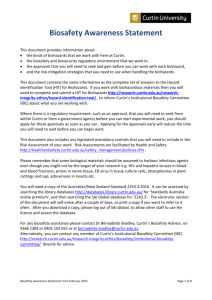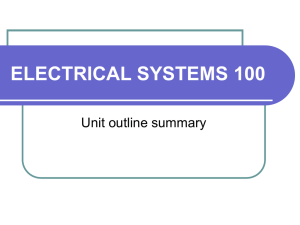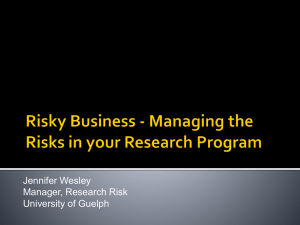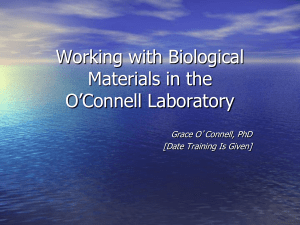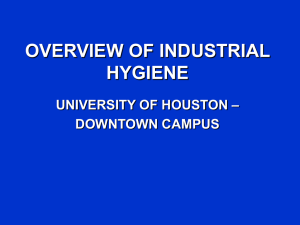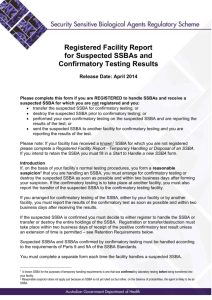This document provides information about
advertisement
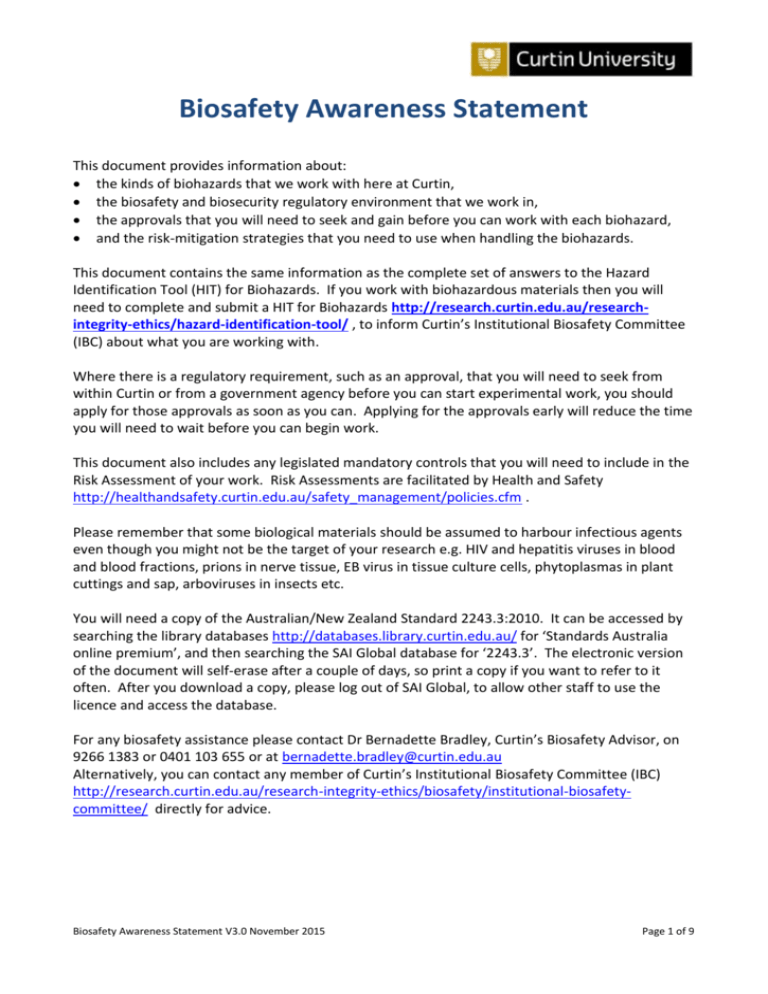
Biosafety Awareness Statement This document provides information about: the kinds of biohazards that we work with here at Curtin, the biosafety and biosecurity regulatory environment that we work in, the approvals that you will need to seek and gain before you can work with each biohazard, and the risk-mitigation strategies that you need to use when handling the biohazards. This document contains the same information as the complete set of answers to the Hazard Identification Tool (HIT) for Biohazards. If you work with biohazardous materials then you will need to complete and submit a HIT for Biohazards http://research.curtin.edu.au/researchintegrity-ethics/hazard-identification-tool/ , to inform Curtin’s Institutional Biosafety Committee (IBC) about what you are working with. Where there is a regulatory requirement, such as an approval, that you will need to seek from within Curtin or from a government agency before you can start experimental work, you should apply for those approvals as soon as you can. Applying for the approvals early will reduce the time you will need to wait before you can begin work. This document also includes any legislated mandatory controls that you will need to include in the Risk Assessment of your work. Risk Assessments are facilitated by Health and Safety http://healthandsafety.curtin.edu.au/safety_management/policies.cfm . Please remember that some biological materials should be assumed to harbour infectious agents even though you might not be the target of your research e.g. HIV and hepatitis viruses in blood and blood fractions, prions in nerve tissue, EB virus in tissue culture cells, phytoplasmas in plant cuttings and sap, arboviruses in insects etc. You will need a copy of the Australian/New Zealand Standard 2243.3:2010. It can be accessed by searching the library databases http://databases.library.curtin.edu.au/ for ‘Standards Australia online premium’, and then searching the SAI Global database for ‘2243.3’. The electronic version of the document will self-erase after a couple of days, so print a copy if you want to refer to it often. After you download a copy, please log out of SAI Global, to allow other staff to use the licence and access the database. For any biosafety assistance please contact Dr Bernadette Bradley, Curtin’s Biosafety Advisor, on 9266 1383 or 0401 103 655 or at bernadette.bradley@curtin.edu.au Alternatively, you can contact any member of Curtin’s Institutional Biosafety Committee (IBC) http://research.curtin.edu.au/research-integrity-ethics/biosafety/institutional-biosafetycommittee/ directly for advice. Biosafety Awareness Statement V3.0 November 2015 Page 1 of 9 Are you planning to conduct research or teaching activities involving human subjects? The use of human subjects in research is legislated by the National Health and Medical Research Council Act (1992) and described by The National Statement on Ethical Conduct in Human Research (2007). At Curtin, the Human Research Ethics Committee (HREC) oversees all research involving human subjects. You will need to apply for approval from the Human Research Ethics Committee (HREC) http://research.curtin.edu.au/research-integrity-ethics/human-research-ethics/ before you can begin to work with humans. This application process can take several weeks, so start early to avoid delays to your Project. If you are planning to do this research at a non-Curtin university or hospital, that institution may have a HREC of their own. You will need to apply to the non-Curtin HREC for approval to perform your work. You will then need to apply to Curtin's HREC to recognise the approval from the other institution. For your Risk Assessment, the hazard is harm to the human test subject. The control is seeking and gaining approval from the Human Research Ethics Committee. Are you planning to conduct research or teaching activities involving animal subjects? The use of animal subjects in research is legislated by the Animal Welfare Act (2002) and described by the Australian code of practice for the care and use of animals for scientific purposes (8th edition 2013). At Curtin, the Animal Ethics Committee (AEC) oversees all research involving animals. You will need to apply for approval from the Animal Ethics Committee (AEC) http://research.curtin.edu.au/research-integrity-ethics/animal-research-ethics/ before you can begin to work with animals. This application process can take several weeks, so start early to avoid delays to your Project. If you are planning to do this research at a non-Curtin university or hospital, that institution may have an AEC of their own. You will need to apply to the non-Curtin AEC for approval to perform your work. You will then need to apply to Curtin's AEC to recognise the approval from the other institution. For your Risk Assessment, the hazard is harm to the animal test subject. The control is seeking and gaining approval from the Animal Ethics Committee. Are you planning to conduct research or teaching activities involving samples taken from humans or animals? (for example: blood, sputum, tissue, urine, faeces, etc) You may need to apply for approval from the Human Research Ethics Committee or Animal Ethics Committee http://research.curtin.edu.au/research-integrity-ethics/human-research-ethics/ or Biosafety Awareness Statement V3.0 November 2015 Page 2 of 9 http://research.curtin.edu.au/research-integrity-ethics/animal-research-ethics/ before you source samples from humans or animals, please check. All samples from humans or animals need to be handled as Risk Group 2, within a Class II Biosafety Cabinet inside a PC2 facility, unless they are known to contain microorganisms from RG3/4. For information about how to handle the samples, refer to AS/NZS2243.3:2010 and http://www.safeworkaustralia.gov.au/sites/SWA/about/Publications/Documents/263/NationalCo deOfPractice_Control_WorkRelatedExposure_Hepatitis_HIVViruses_NOHSC2010-2003_PDF.pdf . If you are able to handle your samples in this way then you do not need to seek IBC approval to do this work. However, if you can’t comply with these two documents for any reason, or you are not sure, then please contact the Biosafety Advisor, who will help you to seek IBC assessment and approval before you can begin work. Samples from humans can infect you with diseases that those people carried. Samples from animals can infect you with zoonotic diseases that those animals carried. Please see the linked document about zoonoses for more information http://www.dpi.nsw.gov.au/biosecurity/animal/humans/zoonoses-transmission . Some immortalised cell cultures have been genetically modified, please always check if an Exempt Dealing is required. Some cancer cell lines are able to colonise a person if the cells are aspirated into the lungs or get in the eyes. Please treat those cancer cell lines as infectious. It is recommended that you get the appropriate immunisations listed in The Australian Immunisation Handbook 10th Edition 2015 http://www.health.gov.au/internet/immunise/publishing.nsf/Content/Handbook10home~handbook10part3~handbook10-3-3#3-3-7 . There may be other vaccinations available that are relevant to the samples you are handling. If you are planning to do this work at a non-Curtin site, you still must handle your samples safely, to the standard described above. If you need to transport your samples, you must transport them following the Guidelines for transporting biohazards . For your Risk Assessment, the hazard is harm to the human or animal test subject. The control is seeking and gaining approval from the HREC or AEC. For your Risk Assessment, the hazard is infection with a pathogen originating from your sample. The first control is handling the sample under PC2 conditions or using methods approved by the IBC. A second control is vaccination. Are you planning to conduct research or teaching activities involving an Australian native animal, or samples/parts from an Australian native animal? (for example: fish, vertebrates, insects, invertebrates, fur, skulls, feathers, carcasses, bones, scats) Biosafety Awareness Statement V3.0 November 2015 Page 3 of 9 Native animals are protected under the Wildlife Conservation Act (1950). Aquatic species may also be protected under the Fish Resources Management Act (1994). 1. Please consider the requirements for a fauna licence http://www.dpaw.wa.gov.au/plants-andanimals/licences-and-permits/134-fauna-forms . 2. Please also consider the requirements for a licence for fish and crustaceans http://www.fish.wa.gov.au/Pages/Home.aspx . For your Risk Assessment, the hazard is harm to native animal populations. The control is seeking and gaining approval from the appropriate government department. Are you planning to conduct research or teaching activities involving Australian native plants, or parts of an Australian native plant? (for example: algae, flowering plants, and non-flowering plants, seeds, flowers, leaves, branches, roots) Native plants are protected under the Wildlife Conservation Act (1950). 1. Please consider the requirements for a flora licence http://www.dpaw.wa.gov.au/plants-andanimals/licences-and-permits/135-flora-licences . For your Risk Assessment, the hazard is harm to native plant populations. The control is seeking and gaining approval from the appropriate government department. Are you planning to conduct research or teaching activities involving a poisonous/toxic plant? Poisonous/toxic plants must be handled to protect workers from the poison/toxin. Please contact the Biosafety Advisor, who will help you to seek IBC assessment and approval, before you can begin work. For your Risk Assessment, the hazard is being poisoned by the plant. The IBC will advise you about the controls you will need to use. Are you planning to conduct research or teaching activities involving a weedy plant listed on the Department of Agriculture and Food's Declared Plants List? (search for “Declared Plants List” on the DAFWA website http://www.agric.wa.gov.au/) Plants on the Declared Plants List must be handled following the guidelines on the List. You must not release a pest plant into the environment. For your Risk Assessment, the hazard is harming the natural or agricultural ecosystems by invasion of a weedy plant. The control is to fully contain the plant by following the guidelines on the Declared Plants List at all times. Biosafety Awareness Statement V3.0 November 2015 Page 4 of 9 Are you planning to conduct research or teaching activities involving biting/stinging or venomous/toxic invertebrates that could harm the handlers? (for example: bees, ants, jellyfish, coral) Biting/stinging or venomous/toxic invertebrates must be handled to protect workers from the bite/sting or venom/toxin. Please contact the Biosafety Advisor, who will help you to seek IBC assessment of your handling methods, and approval, before you can begin work. For your Risk Assessment, the hazard is poisoning with invertebrate venom. The IBC will advise you about the control measures that you will need to take. Are you planning to conduct research or teaching activities involving insects that are able to act as vectors for human, animal and plant disease? (for example: mosquitoes, ticks, thrips) Please consult Section 3 of the AS/NZS2243.3:2010 to identify the Risk Group that those insects should be handled at, and handle them using the appropriate Physical Containment level (Section 5 of the AS/NZS2243.3:2010). If you are able to handle the insects at the same PC level as their RG then you do not need to seek IBC approval to do this work. However, if you can’t comply with these two sections of the Standard for any reason, or you are unsure, then you will need to contact the Biosafety Advisor, who will help you to seek IBC assessment of your handling methods, and approval before you can begin work. For your Risk Assessment, the hazard is infection with disease spread by the vector. The first control is handling the sample under at least PC2 conditions or using methods approved by the IBC. A second control may be vaccination. Are you planning to conduct research or teaching activities involving microorganisms in Risk Groups 2, 3 or 4? All microorganisms in Risk Groups (RG) 2, 3 or 4 need to be handled at the appropriate corresponding Physical Containment (PC) level (e.g. PC2 for RG2). For information about how to handle the samples, refer to Sections 3-5 of the AS/NZS2243.3:2010 (the Australian/New Zealand Standard 2243.3:2010 can be accessed by searching the library databases http://databases.library.curtin.edu.au/ for ‘Standards Australia online premium’, and then searching the SAI Global database for ‘2243.3’). If you can handle your microorganism at the same PC level as their RG then you don’t need IBC approval. This includes handling the microorganism entirely within a Class II Biosafety Cabinet if it can be infective via the respiratory route. However, if you need to use non-Standard methods, then please contact the Biosafety Advisor biosafety@curtin.edu.au , who will help you to seek IBC assessment of your methods, and approval, before you can begin work. Some animal pathogens are zoonotic and can infect you. Please see the linked document about zoonoses for more information http://www.dpi.nsw.gov.au/biosecurity/animal/humans/zoonoses-transmission . Biosafety Awareness Statement V3.0 November 2015 Page 5 of 9 There are vaccines available for some pathogens. It is recommended that you get the appropriate immunisations listed in The Australian Immunisation Handbook 9th Edition 2008 http://www.health.gov.au/internet/immunise/publishing.nsf/Content/Handbook10home~handbook10part3~handbook10-3-3#3-3-7 and any other relevant vaccinations. If you are planning to do this work at a non-Curtin site, you still must handle your microorganisms safely, to the standard described above. If you need to transport your microorganisms, you must transport them following the Guidelines for transporting biohazards. For your Risk Assessment, the hazard is infection with disease. The first control is handling the sample under the appropriate Physical Containment conditions or using methods approved by the IBC. A second control may be vaccination. Are you planning to conduct research or teaching activities involving any of the Security Sensitive Biological Agents (SSBA) listed here: • Abrin (reportable quantity 5 mg), • Bacillus anthracis (Anthraxvirulent strains), • Botulinum toxin (non-therapeutic forms, reportable quantity 0.5 mg), • Ebolavirus, • Foot-and-mouth disease virus, • Highly pathogenic influenza virus infecting humans, • Marburgvirus, • Ricin (reportable quantity 5 mg), • Rinderpest virus, • SARS coronavirus, • Vibrio cholerae (Cholera) (serotypes O1 and O139 only), • Yersinia pestis (Plague), • African swine fever virus, • Capripoxvirus (Sheep pox virus and Goat pox virus), • Classical swine fever virus, • Francisella tularensis (Tularaemia), • Clostridium botulinum (Botulism; toxin-producing strains), • Lumpy skin disease virus, • Peste-des-petits-ruminants virus, • Salmonella Typhi (Typhoid), • Variola virus (Smallpox), • Yellow fever virus (non-vaccine strains) All activities related to SSBAs are regulated by the National Health Security Act (2007) – Part 3. It is illegal to have any SSBA unless it is being held following all the requirements of the SSBA regulatory system. Please contact the Biosafety Advisor bernadette.bradley@curtin.edu.au and the Chair of the IBC d.groth@curtin.edu.au immediately, to discuss the possibility that you might be able to work with SSBAs in the future, once the proper registration has been gained from the Federal Government Department of Health and Aging. For your Risk Assessment, the hazard is providing people with access to weaponisable pathogens or toxins that could be used in the production of bioweapons. The control is to work within the SSBA regulatory system, that restricts the public access to those samples. Biosafety Awareness Statement V3.0 November 2015 Page 6 of 9 For your Risk Assessment, the hazard is infection with disease. The first control is handling the sample under the appropriate Physical Containment conditions or using methods approved by the IBC. A second control may be vaccination. Are you planning to conduct research or teaching activities involving culturing microorganisms from environmental or biological specimens likely to contain an SSBA? (for example: from soil, wastewater, manure, animal carcasses, human excreta) All activities related to SSBAs are regulated by the National Health Security Act (2007) – Part 3. It is illegal to have any SSBA in your possession unless it is being held following all the requirements of the SSBA regulatory system. It is possible to culture an SSBA from an environmental sample or a biological sample. When you become aware that you have cultured a presumptive SSBA, you must immediately contact the Biosafety Advisor bernadette.bradley@curtin.edu.au 0401 103 655 or the Chair of the IBC d.groth@curtin.edu.au . For your Risk Assessment, the hazard is providing people with access to weaponisable pathogens or toxins that could be used in the production of bioweapons. The control is to work within the SSBA regulatory system, that restricts the public access to those samples. For your Risk Assessment, the hazard is infection with disease. The first control is handling the sample under the appropriate Physical Containment conditions or using methods approved by the IBC. A second control may be vaccination. Are you planning to conduct research or teaching activities involving a genetically modified organism GMO? (GMOs include many commercially available and gifted: cell cultures, mouse models, clones, microorganisms containing constructed plasmids, and viral vectors. The use of GMOs includes their purchase, importation, construction, culturing, and storage.) The use of all GMOs is regulated by the Federal Government Gene Technology Act (2000) and Regulations (2001). If you want to work with GMOs then you must work within this gene technology regulatory system. The system regulates all activities with GMOs, including their purchase, importation, construction, culturing, storage and disposal. At Curtin, the use of all GMOs also needs IBC approval before you can begin. If your line manager already has a GM Dealing that covers the work that you want to do, then you need to: • Read the Dealing, and any OGTR Guidelines sited in the Approval email, and for NLRDs: sign the signoff sheet. • Attend the OGTR training session, and your lab manager will let you know when that will be held. If you do not have a GM Dealing to cover your work, then please apply for IBC approval by following the steps on this website http://research.curtin.edu.au/research-integrityBiosafety Awareness Statement V3.0 November 2015 Page 7 of 9 ethics/biosafety/genetically-modified-organisms/ . You cannot purchase or begin to work with a GMO until you have IBC approval. You will also need to attend the next OGTR training session, and your lab manager will let you know when that will be held. For your Risk Assessment, the hazard is disrupting the genetic integrity of the species in question. The control is to work within the gene technology regulatory system, to contain the GMOs so that they are not released into the environment. Are you planning to conduct research or teaching activities involving importing biological material from overseas? There are two levels of quarantine that apply to Western Australia – there is State quarantine between WA and the Eastern States of Australia https://www.agric.wa.gov.au/biosecurityquarantine/quarantine , plus there is Federal quarantine between Australia and overseas http://www.daff.gov.au/biosecurity . There are several Acts of law that cover quarantine, and it is illegal to import any biological material without adhering to all the Guidelines and Regulations associated with those Acts. You might need import permits from both Federal and State quarantine, or you might just a need Federal quarantine import permit, or you might not need any permits at all. Follow the steps on Curtin's Quarantine webpage to search for whether you need to apply for an Import Permit. The Biosafety Advisor can help you. Your Supervisor can hold, or apply for, permits to cover your Project, or you can hold the Permits yourself. You will need to transport the samples following the Guidelines for transporting biohazards. Please send a copy of any WA import Approvals to the Biosafety Advisor bernadette.bradley@curtin.edu.au . For your Risk Assessment, the hazard is introducing novel species and/or diseases into WA to disrupt native and/or agricultural ecologies. The control is to work within the biosecurity regulatory system, and to follow the Import Conditions on the Import Permit. Are you planning to conduct research or teaching activities involving transporting biological material from the Eastern States into Western Australia? WA State quarantine operates between WA and the Eastern States of Australia https://www.agric.wa.gov.au/biosecurity-quarantine/quarantine . You might need an Approval from Quarantine WA before you can bring materials across Australia. Follow the steps on Curtin's Quarantine webpage to seek Approval. If you would like help to apply for your import Approval then please contact the Biosafety Advisor. Please send a copy of any Approvals to the Biosafety Advisor bernadette.bradley@curtin.edu.au . You will need to transport your samples following the Guidelines for transporting biohazards. Biosafety Awareness Statement V3.0 November 2015 Page 8 of 9 For your Risk Assessment, the hazard is introducing novel species and/or diseases into WA to disrupt native and/or agricultural ecologies. The control is to work within the biosecurity regulatory system, and to follow the Import Conditions on the Import Approval. Biosafety Awareness Statement V3.0 November 2015 Page 9 of 9
